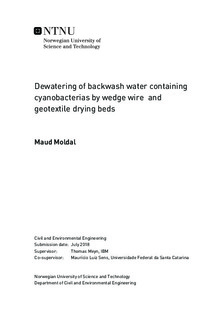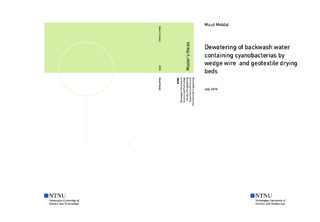| dc.description.abstract | Treatment of effluents are processes with the aim to decrease contaminants to a level were it can be returned to a water source with minimal impact on the environment. In order to release effluents, treatment goals set by respective governments need to be met. A common method to dewater sludge is sludge drying beds that is an easy and cheap method to dewater sludge. Upgraded versions of the conventional sand drying beds is the wedge wire blocks and geotextile filter cloth, which enhances the sludge drying and drainage time.
The purpose of this research was to evaluate the performance of the mentioned drying beds as a method to dewater the backwash water from the WTP at Lake Peri, Brazil. The laboroatory tests were conducted at the site starting by determining the optimum dosage of conditioner. These tests were carried out by adding different doses in the Jar-test equipment before filtering the water through pilots of the drying beds before the drained water was collected to measure turbitity. The optimum conditioner dosage were determined to be 12,5 mg/L PAC and 1 mg/L cationic polymer with a removal in turbidiy of 37% and 92 % in the WW and FC filters respectively. The pilots were built in isopor boxes with a inner dimension of 30 x 30 cm. The wedge-wire block has openings of 0,38 mm x 1,8 cm with a total open area of 11%, while the filter cloth had a density of 700 threads per meter in the horizontal direction, giving a pore opening of 1mm. A sedimentation test was performed to evaluate if sedimentation prior to the drainage test could be a solution, but very light flocs with good floating properties resulted in not implementing this step in the pilot. Further experiments with the pilots showed respectively 49% and 53% removal of BOD5 in the WW- and FC-pilots, which is not meeting the treatment requirement of 60%. Settleable matter increased from 1,8 mL/L to 34 mL/L in the WW-pilot, moving far from the requirement of 1 mL/, while it in the FC-pilot decreased to 0,8 mL/L. The results from the study indicated that neither of the evaluated pilots are suitable for dewatering of the backashwater at lake Peri WTP.
Keywords: cyanobacteria, conditioning, dewatering, drying bed, rapid filtration, wedge wire, water treatment | |

